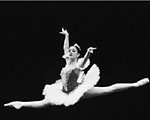THE DANCE HERITAGE COALITION, a group of dance historians and archivists, recently launched “100 Irreplaceable Dance Treasures,” a program designed to identify dance works that are most in need of or worthy of preservation. Pacific Northwest Ballet’s “Tradition and Innovation” program covers a bit over 100 years of ballet history and includes at least two works that are bona fide candidates for any such list.
Pacific Northwest Ballet
Seattle Center Opera House till November 13
The program opens with George Balanchine’s midcentury Agon, an example of neoclassicism where the conventions of 19th-century ballet are stripped down to major components and presented without embellishment. It is set to music from Igor Stravinsky’s atonal period and creates a kind of movement parallel to that stringent quality. Although the score is rhythmically complex, the choreography draws our attention to its overarching thematic development, making it easier to hear the structure and giving us a skeleton to hang our impressions on. In a series of trios, duets, and ensembles, Balanchine examines the body’s kinetic potential: feet flexing and pointing, legs turning in and out, arms sweeping in giant arcs or bobbing along like a jogger’s.
The final pas de deux is made of relatively short phrases with the possibility for quick changes in tone or mood. The dance moves from playful to acerbic, with momentary stops at romantic, comic, and cruel. Initially we see the strangeness of the movement, Balanchine’s upending of standard positions and sequences, but once our eyes adjust to this new palette we can take in the subtlety of the relationship that is being developed, with volition shifting between partners and control up for the taking. Their intense concentration draws the viewer in, so that when the dancers seem to collapse on each other’s shoulders at the end of the section, the audience can take a breath at last.
MANY CHOREOGRAPHERS have featured the waltzes and intermezzi of Johannes Brahms from varying points of view. Balanchine himself staged the first half of his Liebeslieder Waltzer in a ballroom, complete with tufted furniture and heeled slippers for the women. Modern choreographers Charles Weidman and Isadora Duncan each took more abstract approaches, from humorous to monumental. In his 1969 Intermezzo, Eliot Feld follows a middle ground, suggesting but not illustrating the social conventions of Brahms’ period. His dancers live in a world that is romantic without being sentimental or histrionic—a delicate equilibrium. The three couples embody many different qualities over the course of the ballet, from swooning delight to playful buoyancy. The piece is long and full of beautiful detail, making frequent references to ballroom dance steps. Feld is not ashamed to mirror the repetitive structure of the music in his choreography, letting us see a phrase several times until we feel the same intimacy with it that we do with the familiar piano score. By the time the piece spins out to an attenuated finish, Feld has created a little world far from the ironic one outside the theater.
The oldest work on the program, though not necessarily the one in most need of preservation, is a suite of dances from the 19th-century ballet Paquita by Marius Petipa. With its story and characterization eliminated, this is an exercise in straight-ahead classical technique. The ensemble sections are full of the wheeling and flanking maneuvers that Petipa used to work out on a chess board before he came to rehearsals, and the solo variations are short distillations of particular skills or qualities. Whether it’s a series of leaps across the stage or a long curving line of tiny steps on pointe, there is a family resemblance to school figures in ice skating—this dancing is so exposed that any error is immediately visible. This includes the variation for the principal woman, containing a long series of fouett鳬 whipping turns that seem to reduce even the most charitable members of the audience to vultures, waiting for the dancer to stumble or lose her equilibrium.
Donald Byrd’s Subtext Rage is indeed full of anger, its two couples alternately batting each other away or grappling desperately. He often uses the exposed nature of ballet technique, its extreme outward rotation, metaphorically, as a kind of self-exposure for the dancers. Although Byrd seems overly aware of his predecessors (with several references to Balanchine ballets), he’s developing his own use of the canonical vocabulary. Subtext Rage is not in the top 100 dances of the 20th century, but he can certainly work toward the 21st.








